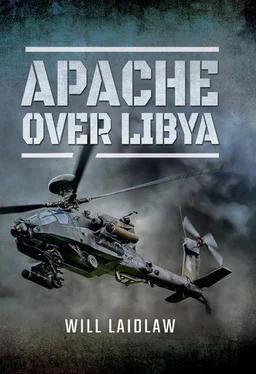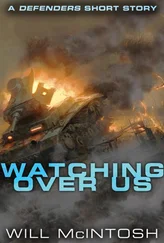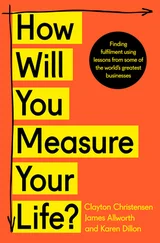I flew front seat with John Blackwell in the rear seat. Nick was front seat with Little Shippers as rear seat. Big Shippers and Jay Lewis paired up just as they had over the winter in Afghanistan, with Big Shippers, unusually, commanding from the rear seat. Mark Hall sat in the front with Charlie Tollbrooke on the sticks; and Reuben Sands was front-seater, with JB’s thousands of flying hours piloting from the rear seat.
The balance had to be on the safe handling of the aircraft low-level over the sea at night. Where a rear-seater was qualified in both seats (most were) and he was the more experienced pilot, I opted to keep him on the sticks – this was where the critical flying would come from. Exactly half of the aircrew were qualified in both seats and could have flown from either seat and commanded missions as well as their own aircraft. I was spoilt for experience and had to make some tough choices. Over Libya fast decisive action would be needed from the front-seaters, but it was the rear seat pilots who performed the immediate life-saving manoeuvres. Given the perils of night and the Mediterranean, I was convinced accuracy on the flying controls would make the difference between coming unstuck and mission survival. The ability to fall back on experience was crucial. Handling the huge bison of an aircraft at speed, low-level, while evading incoming fire and having enough situational awareness to avoid pylons, wires, buildings, the other aircraft or tipping a rotor blade into the desert or the sea – all this required high skill. Then there was the possibility of an in-flight emergency and the need for safe control of an aircraft while diagnosing that emergency in a hostile place. The natural hazards and the possibility of mechanical failures were exacerbated by the unknown magnitude of the threat. Each crew was balanced for skill and decision-making. They all knew they had the skill to take on the targets. What none of us knew was how hostile pro-Gad was going to be in response.
The threat to us from the ground consisted of a whole new and terrifying list of things we talked about in training but hadn’t needed to consider on operations for years. We were used to air superiority, troops on the ground and an enemy we knew we could overmatch. This was very different, there was so much that we did not know. Flicking through some recent photos of the Libyan conflict taken from Google, our trusty source of ground intelligence, Charlie Tollbrooke cantered through the possibilities:
First up, the triple-A threat, ZPU-23-1, 2, ZU 23-2 and ZPU 4. One, two or four barrels. The old ZPUs have a 14.5mm round, fire at 150 rounds per minute and are effective out to about 3,000 to 5,000ft. The replacement ZPUs are much neater, a 23mm round and good out to 2–4km. The Intelligence Officer estimates around 20,000 of these in the country. Everyone has one, usually mounted on the back of a pick-up truck, known as a ‘technical’. It will get you, but they have to see you to aim it. This is standard for all the other triple-A in theatre. They probably have Night Vision Goggles too.
With the triple-A covered, he moved on to the high-end heat-seeking missile threat:
MANPADS. SA-7, 14, 16, 18 and the newest and most brilliant SA-24 are all on show. There are thousands of them. You probably won’t know anything about it until the American lady in the wing tells you one is in the air. Flares, flares, flares, gentlemen!
Charlie clicked to photos of the MANPADS. We had all seen the videos on YouTube of the MiG23 shot down in March, probably by an SA-18 or 24. The high-end double-digit infrared (IR) threat was a plague in Libya. The photos didn’t matter, the ensuing conversation about what profile to fly and what our DAS could do to help against missiles with counter-counter-measures was the important thing. These conversations are always private and I will not record them here – we knew what to do if we met such a missile one dark night.
Now for the radar threat. ZSU 23-4, quick radar tracks the guns, four of them, 23mm, hence the name, but you all knew that. It will reach you at 5km, but inside 3km is best for him. A 3-second burst will send 200 rounds per barrel at about 1,000m a second to the azimuth and elevation the radar tells it. If you are there, then it will do you.
‘How many of these?’ I asked.
Several hundred apparently, and not too many have been hit so far, probably because it’s a 20-tonne vehicle and they turn the radar off and hide. It hasn’t been out much because it can’t reach the jets, although it has been seen firing horizontally in the ground war. It’s a helicopter-catcher and with such a quick radar, which I forgot to say, will track you out to 20km providing there isn’t much clutter to confuse it, perfect for positioning on the coast to watch us coming in. We should expect it. But this is a risky one for both sides. ZSU turns on his radar to track us and the jets will pick up his energy. If he’s on for long enough he’ll get shwacked. If we’re on his radar for long enough, and we get in range of the gun, we’ll get shwacked, by him.
‘How long is long enough?’ Me again.
A couple of seconds. That’s why it’s risky. He’ll have to turn his radar on, track us and then switch it off to avoid the attention of a jet. If we get in range he’ll probably turn it on long enough to get one of us, but the other aircraft or the jet will almost certainly get him. Not a good career choice just now. But still, he’ll undo our evening in a very bad way too.
My notebook was filling up. ‘Happy days, we’ll draw lots for that mission. What else?’
SA-8, the Gecko. Mobile radar and missiles. Big problem. Very savvy operators. Very few systems, but they move around and are reckoned to be in the urban areas in point defence. They occasionally switch on and then off and quickly hide. Tripoli most likely. Nothing else known. Of course you all know it will lock on and launch in seconds and the missile does the thinking after that.
‘Not so keen on that mid-afternoon Tripoli fly-past now.’ Nick raised a laugh.
‘Not before the weekend, old boy. Crawl, walk, run and all,’ I said, needing the whole session to be over. We were going into all of that in 48 hours and I wanted to work out the possibilities and our reaction to the hostility if it was waiting for us.
The severity of these systems was staggering. We were used to the odd AK47 or PKM heavy machine gun chancer. Exceptionally, in our recent operational experience an isolated triple-A incident might concentrate the mind. Now the threat was like being the sole pawn in the middle of a 3-D chess match. Whatever height, speed or profile we flew, something could hit us. The Apache and the skill of the aircrew was all that could make the difference between living and dying.
Throughout the planning I never had any concerns over what we would do once we arrived at a target. Our judgemental training has always been first rate, we understood the Rules of Engagement and their application; Chris James had done that assurance in Cyprus and he had done the same for every Apache pilot deploying to Afghanistan for the previous two years. We were well drilled on the decision-making process, we had watched hours of guntape and discussed complicated scenarios.
I knew the crews would make the right trigger decisions in the interest of the operation and its legal basis (‘can I shoot?’), and also the right moral decisions (‘should I shoot?’). Our collective worry was how to deal with the unprecedented threats. Heat-seeking missiles, radars locking on and triple-A were going to be there to meet us. We would be flying within their range and they were quite able to shoot us down. The almost 900 miles of Gaddafi-controlled coastline would be picketed by scouts, all there to report the sound of helicopters. Just inland from the scouts, the MANPAD and triple-A teams would stay hidden until a shot was possible. As soon as helicopters were in range they would fill the sky. PKM-man and AK-man were also part of the ambush. We faced independent missile systems, large calibre anti-aircraft fire and heavy machine guns just to get into the country. This was our expectation on crossing the coast – and, of course, we would face it all over again when it was time to leave and return to Mother.
Читать дальше












